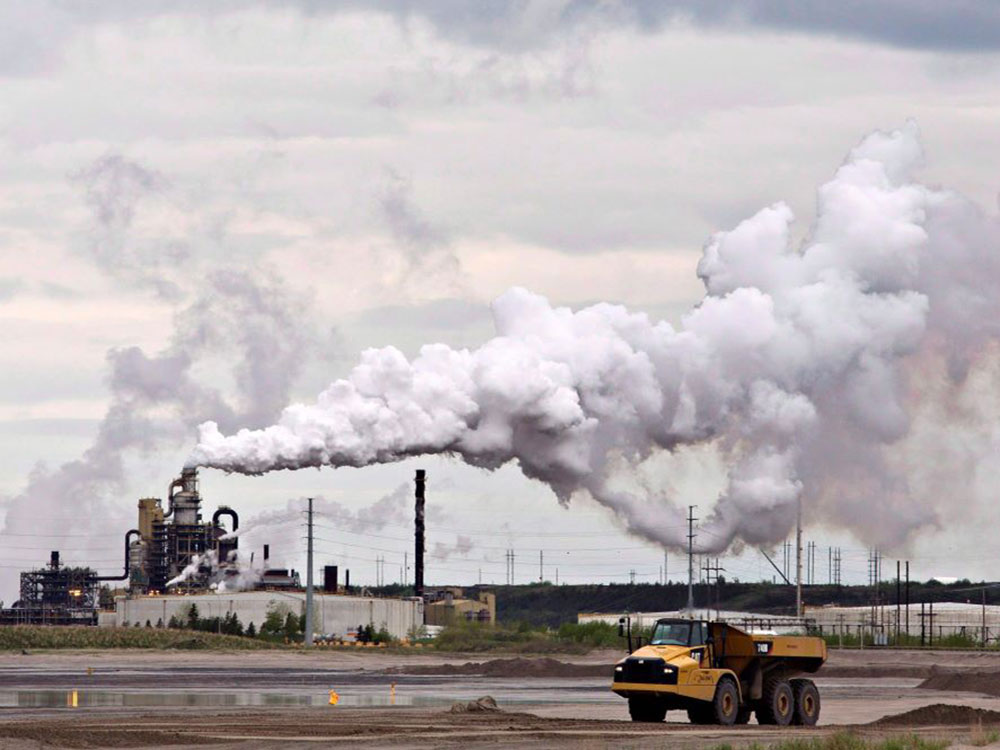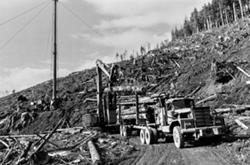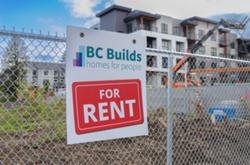Carbon pricing has become a beloved pinata for the political right in Canada. Alberta Premier Danielle Smith recently threatened yet another court challenge to the federal carbon tax. Conservative Leader Pierre Poilievre declared the next election will be a referendum on the signature climate policy of the Justin Trudeau government.
For all the performative caterwauling about the burden of carbon pricing on average Canadians, where is the Conservative outrage about the comparative pittance paid by Canada’s largest emitters?
In 2020, Suncor produced more emissions than the three Maritime provinces combined yet paid about one-fourteenth of the carbon price compared with hard-working Canadian families — about $2.10 per tonne.
That same year, the oilsands mining sector actually profited from Alberta’s bespoke carbon pricing system designed specifically for its large emitters, earning 1.7 megatonnes of tradable carbon credits worth about $54 million. This regulatory alchemy was the bizarre result of extracting 540 million barrels of bitumen with self-reported production emissions greater than the entire province of Manitoba.
Anyone with an internet connection (or a window) can see our accelerating climate emergency is producing unprecedented flooding, forest fires, heat waves and droughts. Carbon emissions are the driving force destabilizing the Earth’s climate with damage topping $16 million per hour and climbing. It is imperative that we accurately account for and aggressively reduce those emissions as quickly as possible through powerful policy tools like carbon pricing.
And while no one enjoys paying taxes, they have been correctly called the price of civilization — an observation even more apt in the context of a climate emergency now threatening the fundamentals of our future.
The idea of carbon pricing is simple: credibly measure greenhouse gas emissions, or GHGs, assign meaningful costs to polluters to incentivize reductions, allocate revenues towards emission reductions and ensure that reporting and enforcement are fair and publicly transparent. Alberta has remarkably achieved the polar opposite of all these principles.
False numbers for oilpatch emissions
Oilsands extraction and upgrading accounts for over 12 per cent of Canada’s total emissions yet employs only 0.67 per cent of Canadians. To better understand how carbon pricing for this outsized sector became so badly broken, let’s start with how emissions are counted (or not).
GHGs from the oilsands — previously estimated to be a whopping 85 megatonnes, or Mt — are in fact closer to 120 Mt. Research published earlier this year by scientists from Environment and Climate Change Canada showed that greenhouse gases originating from bitumen mining and in situ extraction are 65 per cent higher than what industry has claimed based on their self-reported measurements. This research builds on previous studies with similar results published in Nature Communications in 2019.
The scale of carbon miscounting in the oilpatch uncovered by researchers is immense. Approximately 31 Mt of excess annual emissions were identified within the Athabasca oilsands region, which represents about 80 per cent of total oilsands production. If other areas like Cold Lake and Peace River regions have similar discrepancies, then total undercounted emissions might be closer to 38 Mt. That is equivalent to the climate heating from half of all passenger vehicles in the country, or from all the residential buildings in Canada.
So, has the Alberta government made any changes to its emissions sampling or reporting requirements since this emerging science was first published four years ago? Written requests from The Tyee to the Alberta Ministry of Environment and Parks did not receive a response. The authors of the most recent emissions study were also unaware of any plans on the part of provincial regulators to enact changes as a result of their startling revelations.
In theory, these vast newly discovered emissions should also be paid for. Carbon pricing across Canada is now $65 per tonne. At that price, a 38-Mt difference would result in additional annual payments to the Alberta taxpayer of over $2.4 billion in 2023. National carbon prices are mandated to increase by $15 per tonne each year, meaning that by 2030 the apparent undercounting of oilsands emissions should likewise cost companies $6.4 billion per year. Why would any government want to leave that much money on the table?
TIER: Playing favourites with big emitters
Alberta is special. Rather than simply charge everyone the same GHG rates, Alberta set up a stand-alone pricing system custom made for its large emitters like the oilsands. Unsurprisingly these favoured corporate citizens get off much cheaper than rank-and-file taxpayers.
The Alberta Technology Innovation and Emissions Reduction Regulation program, or TIER, was specifically designed to allow Alberta companies with annual GHG emissions larger than 100,000 tonnes to opt out of complying with federal carbon pricing while costing operators far less. The 2023 Alberta budget boasts, “These provincial systems achieve similar environmental outcomes as federal policies but significantly lower the cost burden.”
The TIER program certainly succeeds at the stated goal of reducing the price paid by large emitters to provincial regulators — saving companies $330 million in 2020 compared with the previous system brought in by the former NDP government.
The whole idea of carbon pricing is to create meaningful economic incentives to reduce emissions. No pain, no gain.
Yet the last published compliance report for the TIER program from three years ago shows that the Alberta government collected only $548 million on 154 Mt of industrial GHG emissions, or about $3.55 per tonne. That works out to about 10 per cent of the national carbon price that year of $30 per tonne. The TIER system fared even worse in 2022-23, collecting $255 million on about 160 Mt of GHGs. That works out to about $1.60 per tonne, or three per cent of the rate that you and I paid last year. How is that possible?
Under TIER, companies don’t pay for their absolute emissions. They instead choose to be measured against either their past performance or an industry benchmark, whichever is more beneficial. This means that only 20.6 Mt of 154 Mt in 2020 was “billable carbon.” Companies can also earn, spend or sell carbon credits if their emissions are better than their own past performance or that of their peers.
This regulatory buffet led to the bizarre outcome where bitumen mining companies were awarded more tradable emission credits than they were charged for in 2020, pocketing a tidy profit worth about $54 million. Alberta regulators pledged to plug this loophole; however, there have been no annual compliance reports published on TIER since 2020, so who can say.
Two written requests for clarification from The Tyee to the Alberta Ministry of Environment and Parks went unanswered.
A profitable ‘sham’
Similar carbon credit trading schemes used in other countries have been labelled a sham by local whistleblowers, calling into question whether they are merely a method for polluters to “pay” for their emissions without parting with actual money.
Under Alberta’s TIER program, the proportion of these tradable credits that companies can use to settle up climate costs rather than hand over hard cash also increases over time, rising from 60 per cent in 2023 to 90 per cent after 2025. This timing interestingly coincides with when industry hopes to bring online dubious carbon capture utilization and storage technologies costing billions — largely paid for by the Canadian taxpayer — that may become another lucrative source of carbon credit revenue.
Instead of being a credible pricing system, TIER seems instead to be a regulatory fig leaf to insulate Canadian oil companies from emerging policies from our trading partners like carbon border adjustments.
And it’s a domestic political cudgel to be wielded against federal carbon pricing. The United Conservative Party government amended the regulations in January 2023 with the stated aim of "reducing the opt in threshold to enable more industry to voluntarily be regulated under TIER and thereby not be subject to the federal carbon tax." This pen stroke allowed about 34,000 smaller facilities in Alberta to opt in to TIER and avoid paying emissions pricing to Ottawa.
Turning carbon offsets into oil propaganda
To understand how politically cynical has been the implementation of the TIER program, consider that many of the revenues are earmarked to benefit the very companies contributing to our climate crisis, including funding the oil industry’s public relations efforts. The Canadian Energy Centre, or CEC — also known as the Alberta War Room — has a current budget of over $31 million and is primarily funded from the TIER program.
Rather than being used to reduce emissions, the TIER funds sent to the CEC helped organize an online effort to bully Nanaimo city council into reversing a resolution to ban natural gas hookups on new construction within the municipality.
The same “war room” bankrolls ad campaigns targeting our trading partners in the U.S. and Europe, seeking to create a narrative that oil originating from Canadian bitumen is ethical, well regulated and environmentally responsible. The CEC’s activities in the U.S. are considered so overt they are required to be registered as a foreign agent under the Foreign Agents Registration Act that exists to “identify foreign influence in the United States and address threats to national security.”
Ottawa needs to be fair about carbon pricing
Why is Ottawa allowing such a lax system to displace federal carbon pricing?
Alberta, like all other provinces, has the prerogative to develop its own carbon pricing models as long as they are as good as or better than the benchmarks set by the Canadian government.
Specifically, recent federal guidance states, “Output-based pricing systems for industry must be designed to maintain a marginal price signal equivalent to the minimum national carbon pollution price... across all covered emissions.” How is that requirement consistent with Alberta awarding net carbon credits for bitumen mining operations?
The rationale behind measuring large emitters against their past performance rather than their actual emissions is to avoid what is called carbon leakage, in which companies might relocate their operations elsewhere in the world where carbon pricing was less. But how could oilsands operations possibly relocate anywhere other than where the oilsands deposits are?
The federal government clearly stipulates that “output-based pricing systems... must only apply to sectors that are assessed by the jurisdiction as being at risk of carbon leakage and competitiveness impacts from carbon pollution pricing, and must not apply to sectors that are clearly not at risk.”
Given that Canada’s oil companies are banking obscene profits and are clearly unable to pack up their bitumen mines and take them to other jurisdictions, Ottawa should stop pretending that Alberta’s TIER is equivalent to federal requirements. It is not.
And ordinary Canadians are picking up the carbon pricing slack for a very coddled corporate sector in the midst of a worsening climate emergency.
If Pierre Poilievre and Danielle Smith really want to stand up for hard-working Canadian families, they should tell their freeloading friends in the oil sector to stop leaving all the heavy lifting for the rest of us. ![]()
Read more: Energy, Politics, Alberta, Environment















Tyee Commenting Guidelines
Comments that violate guidelines risk being deleted, and violations may result in a temporary or permanent user ban. Maintain the spirit of good conversation to stay in the discussion and be patient with moderators. Comments are reviewed regularly but not in real time.
Do:
Do not: